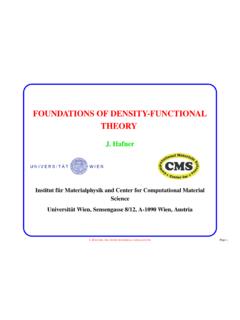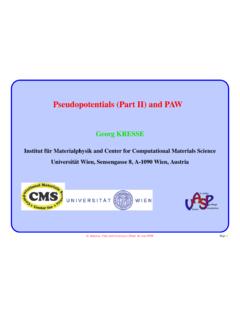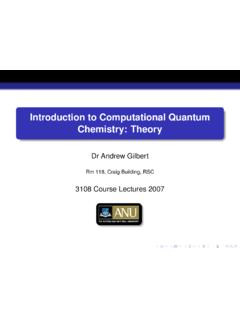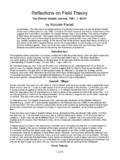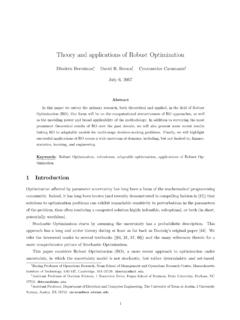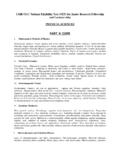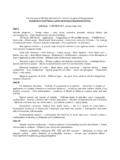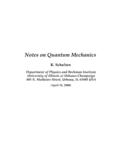Transcription of VASP Workshop: Day 2
1 Intro Frequency Static GWVASP workshop : day 2 Martijn MarsmanComputational Materials Physics, University Vienna, and Center forComputational Materials ScienceVASP workshop at CSC Helsinki 2009 MarsmanVASP workshop : day 2 Intro Frequency Static GW1 Dielectric response2 Frequency dependent dielectric properties3 The static dielectric response4 The GW approximationMarsmanVASP workshop : day 2 IntroFrequency Static GWExperiment:Static and frequency dependent dielectric response functions:measurement of absorption, reflectance, and energy loss spectra. (Opticalproperties of semiconductors and metals.)The long-wavelength limit of the frequency dependent microscopicpolarizability and dielectric matrices determine the optical properties inthe regime accessible to optical and electronic :Frequency dependent polarizability matrix needed in many post-DFTschemes, :GW) frequency dependent microscopic dielectric response) frequency dependent macroscopic dielectric tensor requiredfor theanalytical integration of the Coulomb singularity in the optimized-effective-potential method (EXX-OEP)Bethe-Salpeter-Equation (BSE)) dielectric screening of the interaction potential needed to properlyinclude excitonic effectsMarsmanVASP workshop .
2 day 2 IntroFrequency Static GWFrequency dependentfrequency dependent microscopic dielectric matrix) In the RPA, and including changes in the DFT dependent macroscopic dielectric matrix) Imaginary and real part of the dielectric function.) In the RPA, and including changes in the DFT xc-potential.) In- or excluding local field effectsStaticStatic dielectric tensor, Born effective charges, and Piezo-electric tensor,in- or exluding local field effects) From density-functional-perturbation-theory (DFPT)(local field effects in RPA and DFT xc-potential.)) From the self-consistent response to a finite electric field (PEAD)(local field effects from changes in a HF/DFT hybrid xc-potential.
3 MarsmanVASP workshop : day 2 IntroFrequencyStatic GWMacroscopic continuum considerationThe macroscopic dielectric tensor couples the electric field in amaterialto an applied external electric field:E= 1 Eext,where is3 3tensorFor a longitudinal field, , a field caused by stationary external chargesthis can be reformulated as (in momentum space, in the long-wavelengthlimit):vtot= 1vext,withvtot=vext+vindThe induced potential is generated by the induced change in the chargedensity ind. In the linear response regime (weak external fields): ind= vext,where is thereducible polarizability ind=Pvtot,wherePis theirreducible polarizabilityIt may be straightforwardly shown that: 1= 1 + , = 1 P, and =P+P (a Dyson eq.)
4 Where = 4 e3/q2is the Coulomb kernel in momentum workshop : day 2 IntroFrequencyStatic GWMacroscopic and microscopic quantitiesThe macroscopic dielectric function can be formally written asE(r, ) =Zdr 1mac(r r , )Eext(r , )or in momentum spaceE(q, ) = 1mac(q, )Eext(q, )The microscopic dielectric function enters ase(r, ) =Zdr 1(r,r , )Eext(r , )and in momemtum spacee(q+G, ) =XG 1G,G (q, )Eext(q+G , )The microscopic dielectric functions is accessible through ab-initio and microscopic quantities are linked through:E(R, ) =1 Z (R)e(r, )drMarsmanVASP workshop : day 2 IntroFrequencyStatic GWMacroscopic and microscopic quantities (cont.)Assuming the external field varies on a length scale that is much largerthan the atomic distances one may show thatE(q, ) = 10,0(q, )Eext(q, )and 1mac(q, ) = 10,0(q, ) mac(q, ) =( 10,0(q, )) 1 For materials that are homogeneous on the microscopic scale theoff-diagonal elements of 1G,G (q, )( , forG6=G ) are zero, and mac(q, ) = 0,0(q, )This is called the neglect of local field effects MarsmanVASP workshop .
5 day 2 IntroFrequencyStatic GWThe longitudinal microscopic dielectric functionThe microscopic (symmetric) dielectric function that links the longitudinalcomponent of an external field ( the part polarized along the propagationwave vectorq) to the longitudinal component of the total electric field, is givenby: 1G,G (q, ) := G,G +4 e2|q+G||q+G | ind(q+G, ) vext(q+G , ) G,G (q, ) := G,G 4 e2|q+G||q+G | ind(q+G, ) vtot(q+G , )and with G,G (q, ) := ind(q+G, ) vext(q+G , )PG,G (q, ) := ind(q+G, ) vtot(q+G , ) sG,G (q) :=4 e2|q+G||q+G |one obtains the Dyson equation linkingPand G,G (q, ) =PG,G (q, ) +XG1,G2PG,G1(q, ) sG1,G2(q) G2,G (q, )MarsmanVASP workshop : day 2 IntroFrequencyStatic GWApproximationsProblem:We know neither :The quantity we can easily access in Kohn-Sham DFT is the: irreducible polarizability in the independent particle picture 0(or KS) 0G,G (q, ) := ind(q+G, ) veff(q+G , )Adler and Wiser derived expressions for 0which, in terms of Blochfunctions, can be written as 0G,G (q, ) =1 nn k2wk(fn k+q fn k) h n k+q|ei(q+G)r| nkih nk|e i(q+G )r | n k+qi n k+q nk i MarsmanVASP workshop : day 2 IntroFrequencyStatic GWApproximations the Kohn-Sham system, the following relations can shown to hold = 0+ 0( +fxc) P= 0+ 0fxcP =P+P where is the Coulomb kernel andfxc= vxc/ | = 0is the DFT xc-kernel.
6 1= 1 + = 1 PRandom-Phase-Approximation (RPA):P= 0 G,G (q, ) := G,G 4 e2|q+G||q+G | 0G,G (q, )Including changes in the DFT xc-potential:P= 0+ 0fxcPMarsmanVASP workshop : day 2 IntroFrequencyStatic GWCalculation of optical propertiesThe long-wavelength limit (q 0) of the dielectric matrix determines theoptical properties in the regime accessible to optical macroscopic dielectric tensor ( )1 q ( ) q= limq 0 10,0(q, )can be obtained at various levels of approximation:LOPTICS = .TRUE.) 0,0(q, )in the RPA) neglect of local field effects: q ( ) q limq 0 0,0(q, )ALGO = CHI) Including local field effects: in RPA and due to changes in the DFTxc-potential (LRPA = .TRUE.|.FALSE.
7 MarsmanVASP workshop : day 2 IntroFrequencyStatic GWCalculation of optical properties (cont.)LOPTICS = .TRUE. q ( ) q limq 0 0,0(q, )The imaginary part of ( )(3 3tensor) of which is given by (2) ( ) =4 e2 limq 01q2Xv,c,k2wk ( ck vk ) huck+qe |uvkihuvk|uck+qe iand the real part is obtained by a Kramers-Kronig transformation (1) ( ) = 1 +2 Z 0 (2) ( ) 2 2d The difficulty lies in the computation of the quantities|unk+qe ithe first order change in the cell periodic part of| nkiwith respect to theBloch workshop : day 2 IntroFrequencyStatic GWExpanding up to first order inq|unk+qi=|unki+q | kunki+..and using perturbation theory to write| kunki= n6=n |un kihun k| [H(k) nkS(k)] k|unki nk n kwhereH(k)andS(k)are the Hamiltonian and overlap operator for thecell-periodic part of the wave workshop : day 2 IntroFrequencyStatic GWExamplesGAJDO et REVIEW B73, 045112s2006dMarsmanVASP workshop : day 2 IntroFrequencyStatic GWThe GW potentials: GW POTCARsFIG.
8 2. Atomic scattering properties of the Si TMsleftdandPAWsrightdpotentials used in the present work for QP calculationssTablesIandIId. Shown are the logarithmic derivatives of the radialwave functions for different angular momenta for a spherical Siatom, evaluated at a distance ofr= from the nucleus. Solidlines correspond to the all-electron full-potential, and dotted lines tothe TM pseudopotential or PAW potential. The energy zero corre-sponds to the vacuum level. Circles indicate linearization energiesfor workshop : day 2 Intro FrequencyStaticGWThe static dielectric responseThe following quantities:The ion-clamped static macroscopic dielectric tensor ( = 0)(or simply ).Born effective charge tensorsZ :Z ij= e Pi uj=1e Fi EjElectronic contribution to piezo-electric tensors:e(0)ij= i Ej, i=xx,yy,zz,xy,yz,zxmay be calculated using density functional perturbation theory (DFPT):LEPSILON=.
9 From the SC response of the wave functions to a finite electric field(PEAD):LCALCEPS=.TRUE.(only for insulating systems!)(Useful in case one works with hybrid functionals, where LEPSILON = .TRUE. does not work.)MarsmanVASP workshop : day 2 Intro FrequencyStaticGWResponse to electric fields from DFPTLEPSILON=. of using perturbation theory to compute| kunki, one can solve thelinear Sternheimer equation:[H(k) nkS(k)]| kunki= [H(k) nkS(k)] k|unkifor| linear response of the wave functions to an externally applied electric field,| nki, can be found solving[H(k) nkS(k)]| nki= HSCF(k)|unki q | kunkiwhere HSCF(k)is the microscopic cell periodic change in the Hamiltonian,due to changes in the wave functions, , local field effects(!)
10 : these may beincluded at the RPA level only (LRPA=.TRUE.) or may include changes in theDFT xc-potential as workshop : day 2 Intro FrequencyStaticGWResponse to electric fields from DFPT (cont.)The static macroscopic dielectric matrix is then given by q q= 1 8 e2 Xvk2wkh q kunk| nkiwhere the sum overvruns over occupied states Born effective charges and piezo-electric tensor may be convenientlycomputed from the change in the Hellmann-Feynman forces and themechanical stress tensor, due to a change in the wave functions in a finitedifference manner:|u(1)nki=|unki+ s| nkiMarsmanVASP workshop : day 2 Intro FrequencyStaticGWExamplesTABLE III. The ion clamped static macroscopic dielectric constants `calculated using the PAW methodand various approximations.
